 |
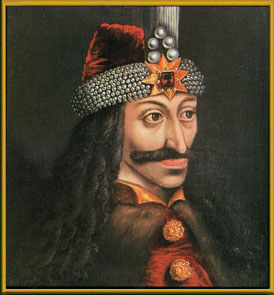 |  he name Dracula conjures up a myriad of dark images in our mind; late night horror movies of vampires and vampire hunters, dark forests in Romania, and tyranical leaders capable of all sorts of evil acts. Here is some background information on the Dracula from which Bram Stoker -- and Jeanne Kalogridis -- were inspired: Prince Vlad Tepes, born 1431, died 1476, ruler of the lands now known as Romania. he name Dracula conjures up a myriad of dark images in our mind; late night horror movies of vampires and vampire hunters, dark forests in Romania, and tyranical leaders capable of all sorts of evil acts. Here is some background information on the Dracula from which Bram Stoker -- and Jeanne Kalogridis -- were inspired: Prince Vlad Tepes, born 1431, died 1476, ruler of the lands now known as Romania.
|
|

This section owes much to Dracula researchers Radu Florescu and Raymond McNally, whose wonderful books IN SEARCH OF DRACULA and DRACULA: PRINCE OF MANY FACES were primary resources in the creation of the FAMILY DRACUL novels. |
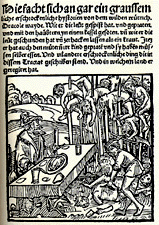 Vlad Tepes (which Kalogridis spells phonetically in English as Tsepesh) was born in the town of Sighisoara in Transylvania (now known as northern Romania) in 1431 and later came to rule that area of southern Romania known as Wallachia. The word "tepes" in Romanian means "impaler" -- and Vlad was so-named because of his penchant for impalement as a means of punishing his enemies. Impalement was a particularly gruesome form of execution, wherein the victim was impaled between the legs -- to put it politely -- upon a large, sharpened stake the width of a burly man's arm. Vlad especially enjoyed mass executions, where several victims were impaled at once, and their stakes hoisted upright. As they hung suspended above the ground, the weight of their bodies would slowly drag them downwards, causing the sharpened end of the stake to pierce their internal organs. In order to better enjoy these mass spectacles, Vlad routinely ordered a banquet table set up in front of his victims, and would enjoy a leisurely supper amid the pitiful sights and sounds of the dying. Vlad Tepes (which Kalogridis spells phonetically in English as Tsepesh) was born in the town of Sighisoara in Transylvania (now known as northern Romania) in 1431 and later came to rule that area of southern Romania known as Wallachia. The word "tepes" in Romanian means "impaler" -- and Vlad was so-named because of his penchant for impalement as a means of punishing his enemies. Impalement was a particularly gruesome form of execution, wherein the victim was impaled between the legs -- to put it politely -- upon a large, sharpened stake the width of a burly man's arm. Vlad especially enjoyed mass executions, where several victims were impaled at once, and their stakes hoisted upright. As they hung suspended above the ground, the weight of their bodies would slowly drag them downwards, causing the sharpened end of the stake to pierce their internal organs. In order to better enjoy these mass spectacles, Vlad routinely ordered a banquet table set up in front of his victims, and would enjoy a leisurely supper amid the pitiful sights and sounds of the dying.
|
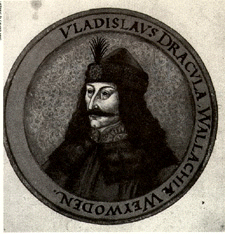 In addition to his title of "Impaler," Vlad was also known as "Dracula," which means "son of the Dragon." Originally, this title came about because his father (also named Vlad) belonged to the Order of the Dragon, an order formed by the Holy Roman Emperor Sigismund for the purpose of defeating the Turks. The elder Vlad used the dragon symbol on his coins and went by the name "Dracul" ("dragon" or "devil"). Hence the diminutive "-a" on his son's name, Dracula. As the younger Vlad's talent for torture became known, however, the name Dracula came to be interpreted more and more as the sinister "son of the devil." In addition to his title of "Impaler," Vlad was also known as "Dracula," which means "son of the Dragon." Originally, this title came about because his father (also named Vlad) belonged to the Order of the Dragon, an order formed by the Holy Roman Emperor Sigismund for the purpose of defeating the Turks. The elder Vlad used the dragon symbol on his coins and went by the name "Dracul" ("dragon" or "devil"). Hence the diminutive "-a" on his son's name, Dracula. As the younger Vlad's talent for torture became known, however, the name Dracula came to be interpreted more and more as the sinister "son of the devil."
|
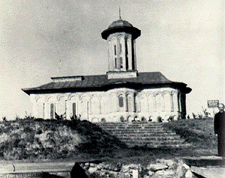 At the same time that Vlad became notorious for his sadism, he was also respected by his subjects because of his fierce campaigns against the Turks. He was a respected as a warrior and stern ruler (no kidding!) who tolerated no crime against his people, and during his reign erected several monasteries. However, despite Vlad's political ambition, the turbulent political atmosphere of the times took its toll on his reign. He was overthrown twice (he ruled for a brief period in 1448, again from 1456-1462, and for only a matter of weeks in the year of his death, 1476.) Ultimately, Dracula died violently (according to rumor, at the hands of one of his men who was actually a Turkish spy). He was buried at one of the monasteries he patronized, on the island at Snagov. The pictures shows the chapel. At the same time that Vlad became notorious for his sadism, he was also respected by his subjects because of his fierce campaigns against the Turks. He was a respected as a warrior and stern ruler (no kidding!) who tolerated no crime against his people, and during his reign erected several monasteries. However, despite Vlad's political ambition, the turbulent political atmosphere of the times took its toll on his reign. He was overthrown twice (he ruled for a brief period in 1448, again from 1456-1462, and for only a matter of weeks in the year of his death, 1476.) Ultimately, Dracula died violently (according to rumor, at the hands of one of his men who was actually a Turkish spy). He was buried at one of the monasteries he patronized, on the island at Snagov. The pictures shows the chapel.
|
|
Contrary to popular belief, Dracula's castle does not exist in Transylvania; the crumbling ruins still stand in the northern Wallachian town of Tirgoviste.
 |
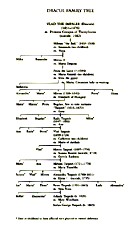 | 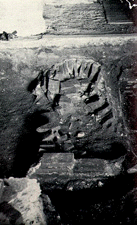 |
The Dracul family tree as given by Jeanne Kalogridis in her novels | Dracula's empty tomb |
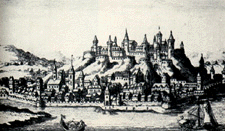 | 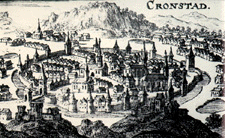 |
Fortress of Belgrade | Cronstad |
|

Authorship and holder of IP rights not provided with original material. Click on pictures for larger version.
|







